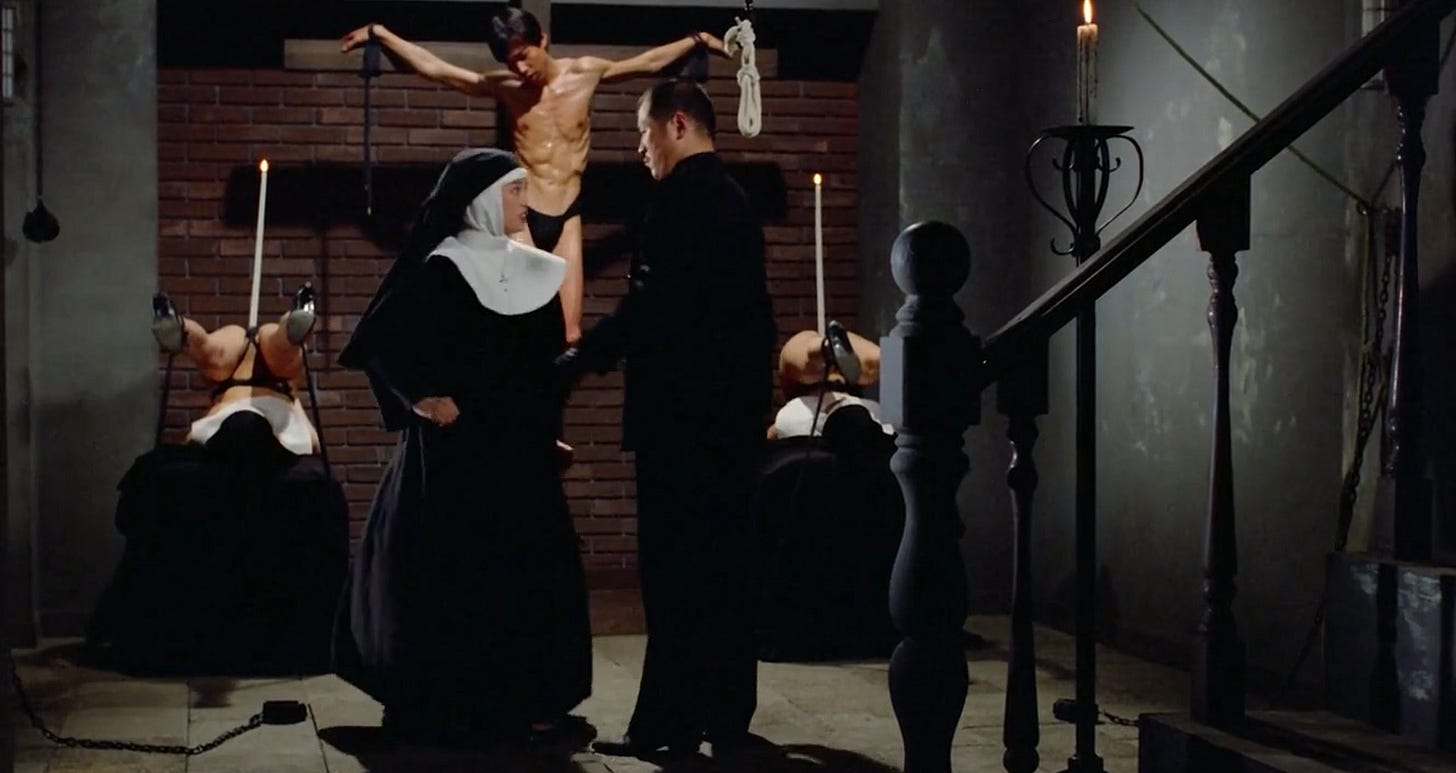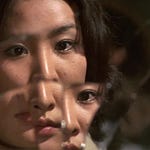After an opening scene of S&M that sees a rose stem refashioned as a whip, Nun In Rope Hell (1984) brings viewers to the Kadowaki Suspension Bridge. I recognized it as a climactic set piece in horror sequel Sadako 3D 2 (2013), but it’s also been featured in Koji Shiraishi’s Occult (2009.) Located in the Shizuoka prefecture, the bridge is suspended right above the Jogasaki Coast. Both from the side and on the bridge itself, the view is astonishing – albeit somewhat terrifying.
This is an appropriate setpiece for director Katsuhiko Fujii and cinematographer Teio Noda to open on. Nun In Rope Hell is as mystifying as it is scary – and twice as erotic by any measure. Fujii pushes major boundaries for not only what a theatrical pink film could show by 1984, but the limits of contemporary rope play. Through artful shot composition and imaginative mise en scene, the film elevates the human body to a work of art in sublime form. Like the Kadowaki Bridge, the weight of this picture rests on the suspended backs of the actresses.
Rope Hell surprises in how it avoids general nunsploitation stock tropes and scenarios. There are no horny priests or arcane rituals in the name of a Christian god figure. Miki Takakura plays a girl who wants to start fresh, after she’s caught making love to a married man. But she soon realizes that the institution is a front for a writer’s perverse fixations, and that the ‘nuns’ are all being secretly coerced into sex via drugs each night.
By this point in the Roman Porno release cycle, a pure sex and bondage picture like this – no enemas or bodily fluids outside of a mouthful of fake sperm – might seem tame. But Fujii, Noda, and production designer Shuuko Goto remind viewers how far rope and some candles can truly go. In one scene halfway through the film – where the narrative truly turns – Takakura is suspended in pure darkness, then bound from head to toe in striking white rope. Her breasts are squeezed and contracted by the bindings; she writhes, but can’t move. Then she awakens inside a car – no less trapped. Each of her four limbs is tied to the vehicle’s grab handles, her body forcibly stressed and suspended. A dreamic nightmare morphs to a waking one in real time, as the viewer scrambles to keep up as they’re led deeper into depravity.
A scene like this is quintessential pink film 101. First, we are treated to a heightened, emotional state of being for the female character – a howling yet vacuous unreality. It’s here that she’s bound, unaware of what’s happening or who’s doing it. This surreal moment is meant to signify her being tied while unconscious. At once, this short sequence is a bit of non-literal storytelling, a dream sequence, and a showcase of careful ropework. When she awakens, the scene becomes real – suddenly, we’re aware that this isn’t a dream, and are trapped in the car with her. Without words, we’re invited to think of the possibility of a badly timed traffic stop or hitting a wrong police trap. What’s erotic about this isn’t just that a oman is being tied up and displayed against her will – it’s the fact that this is being done in the back of a car you might pass on the highway.
A major preoccupation in pink film is the concept of perversion that exists just beneath the surface of polite or popular societal norms. In that sense, much of the genre not only has a spiritual kinship with giallo, but with works like David Lynch’s Blue Velvet as well. Fellow Roman Porno entries White Rose Campus and Woman In A Box both indulge in this not-quite public sex involving vehicles. In the former, a group of hijackers takes a bus of schoolgirls hostage and rape the remaining students after they kick out ‘the ugly ones.’ In the latter, an indulgent couple have sex and spy on unsuspecting potential victims to drug and torture in their basement. These films demonstrate the preoccupation both audiences and creatives had with socially unacceptable acts being done just barely out of public eye.
This fits handily with Rope Hell story writer Oniroku Dan’s conception of BDSM. Dan was one of the originators of what is now conceived of as ‘Japanese S&M’, a style of sadomasochistic play with many distinct characteristics that differentiate it from its Western counterparts. As Dan conceptualizes it, BDSM is focused on shaming and embarrassing beautiful subjects by wresting control and forcing their desires from them. It’s explicitly preoccupied with forcing the recipient to acknowledge that they want and like it.
This Dan quote, from a 1999 interview with Asian Cult Cinema, is a succinct summary of the author’s approach.
My book editors often confuse S/M with cruelty and they want me to write some 'punishment tale' for them. This type of story is out of my realm. It just gives me the creeps. Rather, my concept of S/M is 'distorted sexual desire' or extreme disorientation. It's a male fantasy derived from love... from seeing a beauty suffer through the sense of shame. Therefore, my style contains a romantic, aesthetic, and sometimes decadent fragrance."
This philosophy, built around resistance giving way to one’s innermost desires, is one which dates back to Japan’s colonial enterprises in the first half of the 20th century. It evokes Imperial Japan’s relegation of Korean art, culture, and history as lower than Japan’s own heritage. Through propaganda, the political institution of shinto, and forced reeducation en masse, the Japanese government aimed to assimilate the Korean populace by force – even using forced sex labor to achieve this. Behind this treatment was a plainly stated tone of paternalistic patronizing – the presumption that colonized Koreans ought to be grateful for this treatment. This was based on an erroneous and fanciful understanding that Korea was, in fact, a less evolved, more primitive relative of Japan.
Says Yi Wei in the Yale Review of International Studies,
In the early 1910s, Japanese intellectuals continued the process of knowledge production to legitimize its hold on Korea. Similar to the ethnographic works, portions of these works stressed a simultaneous sameness and difference between Japan and Korea. For instance, as shown in Do-Hyun Han’s work on colonial religious governance, Shamanism was framed as the dominant Korean religion. Japanese colonial scholars argued that Korean Shamanism was a primitive branch of Japanese Shintoism. They argued that in terms of religion, Korean was “below Japan on the evolutionary stage of civilization.” This epistemic installation of Shamanism as the dominant Korean religion showed the workings of the Japanese colonial ideology.
This “knowledge production,” as Wei defines it, was a cornerstone to the economic, political, and religious annexation of Korean by the Japanese military. But though a great number of Koreans were claimed by forced labor, torture, or outright murder, this was not a passive occupation. Collectives formed to push back against the new rule, and though initial resistance was met with over 700 military arrests, Koreans did not stop fighting for not just their independence, but the survival of their culture and history itself.
As Erin Blakemore writes for History,
Though Japan occupied Korea for an entire generation, the Korean people didn’t submit passively to Japanese rule. Throughout the occupation, protest movements pushed for Korean independence. In 1919, the March First Movement proclaimed Korean independence and more than 1,500 demonstrations broke out. The protests were brutally suppressed by the Japanese, but not before the desire for independence swept through Korea.
As this pertains to Dan’s conception of BDSM, then, a parallel can be drawn between the writer’s female characters and Colonial Japan’s conception of Korea. In both instances, there is an inherent belief that the colonized body is receiving what it truly needs and desires against its will. Dan’s work, however, tends to stray far from fascist beliefs or tendencies – though that’s not an absolute rule – and adaptations of it tend to use this power struggle to tease out insightful, incendiary imagery explicitly critical of nationalism.
This is present in Nun In Rope Hell, mainly embodied by smug antagonist Bunzo. Played with confident swagger by Hiroshi Unayama, the writer displays two-way mirrors in his home alongside traditional artwork and scrolls. In a clean, ironed kimono, he walks around his home and observes a woman being raped as if it was a work of art being hung on his wall. The satire here is overt, and it’s a strain of dark comedy echoed by previous Dan works like Flower and Snake. In this strain of dark comedy, the conservative traditionalist’s fine tastes are likened to forced submission brought about via sexual violence. Further, the audience is made complicit in the act on screen, which itself is a conscious utilizing of bystander effect to render viewers helpless, shocked, but nevertheless entranced.
The film presents something an ostensible traditionalist would be offended by, then likens their fixation on national identity to a fetish. That genre of commentary can also be seen in the decadent, perverse rich countryside dwellers of Obayasu’s House, or in the second Guinea Pig installment, Flower of Flesh & Blood. A central preoccupation of post-60s Japanese film – especially after the popularity of Teruo Iishii’s 1968 Shogun’s Joy of Torture – is the destabilization of national hegemony through subversive and decadent art that does not outright state what it is commenting on. Instead, directors relied on coded visual metaphors and prospective audiences’ context – much like European film of the time, especially French cinema – to get across the full weight of their messaging.
In the context of Rope Hell, the Catholic Church in Japan is likened to a perverse farce without a single critical word spoken of religion. Instead, a rapacious writer destabilizes a convent by sheer force of will, and rewrites the focus as one strictly built around sex. Meanwhile, lesbian nuns are doubled over themselves and their vaginal cavities used as makeshift candleholders before being bound together and forced to make love. These are suggestions that an ardent Cathoic would find not only offensive, but possibly decry as blasphemous. Some might even go so far as to lobby misogyny, as it pastiches a place explicitly intended to shelter women.
The narrative itself, then, makes an overt mockery of Christian symbolism by transmogrifying it into fetish and casting it in an inherently oppressive light. But what’s more interesting here is that the commentary could also construed as feminist, albeit unintentionally. Rope Hell makes it explicitly clear that the lesbian nuns are not to touch one another, and both are punished for the ‘sinful’ behavior. Meanwhile, the head nun that Bunzo has wrapped around his finger goes unpunished for her own lust. This is because her lust explicitly centers and empowers Bunzo, along with his other male accomplices. Sexual agency only exists for the male characters, which is an explicit point of the film.
However, modern audiences who don’t have the proper context or understanding for this art may well see it as rape fantasy and little else. Writes critic Steven Gillepsie in a deeply critical review of the picture,
At this point, we are aligned with this character and celebrate her sexuality. The arc seems to be her growing and learning about herself, and the viewer joins her with this, and the expected conflict is a background that represses sexual expression (and is especially condemnatory of feminine sexuality and homosexuality) […] And then it is not that film at all. We segue very suddenly into sexual violence, somewhat foreshadowed by some dreamlike sequences that cover sexual trauma - and are overtly influenced, on an aesthetic level, by Suspiria. However, we are used to the lens being an empowering and accepting one, now that same lens is filming the same body - in the same ways - but the content is sexual assault. The closeups of tongues on nipples, and the way the camera sweeps over the female form, is the same but the context could not be more different. Previously, it was a woman defining her own sexuality and finding pleasure in herself, now it is an act of violence and the antithesis of what came before.
This sort of modern read on pink film is common, and on some level, one that is understandable for Western audiences to arrive at. Both American and British film – which has gone on to dominate cultural tastes the world over – have schools of thought based in, respectively, moral righteousness or logical superiority. An American filmgoer is more likely to balk at behavior they disagree with in a film, especially if they feel the behavior is somehow being encouraged; it’s indicative of my nation’s rejection of education and embrace of “gut feeling” as guiding moral light. Meanwhile, an average British filmgoer tends to seek a reason or purpose for the art they consume, as British culture is built around a rigid and regressive educational hegemony.
Rope Hell and films like them are a challenge, then. To an American, the film’s content is deeply wrong, arguably misogynistic, and offensive to religion. To a Brit, the film’s insinuation of assault giving way to pleasure defies a logical understanding of sexual violence. As such, it’s one of many pink film commonly dismissed by genre tourists as “rape fantasy” that viewers “shouldn’t be into.” While explainable, this perspective on pink film is regrettable at best, ignorant at worst. To fully appreciate this genre as a non-Japanese viewer, a period of detoxification and education is important to let go of rigid Western philosophies that can sully enjoyment or obfuscate intent of a film.
It’s also important to note that this particular film is meant to be scary, even if the sex is artful, softcore pornography. Like many pink films that depict hardcore sexual violence, Takakura’s ordeal and predicament draw stylistic cues from contemporary horror to heighten her panic and terror. One notable and clear influence is Suspiria, which is evoked not only in the hellish nightmare and chase sequences, but in the dizzying camerawork used to represent the protagonist’s deteriorating mental state. It paves the way for other Nikkatsu syntheses of sex and horror released shortly thereafter, such as Entrails of A Virgin (1986) and Woman in a Box films, although it is far from the first pink film to draw from Euro horror.
Equal parts horror and erotica, Nun in Rope Hell, as a whole, is a fun and frequently surprising erotic drama that ensures viewers are also being broken in by Bunzo’s convent. As we are exposed to further acts of decadent depravity, we ask ourselves why we’re watching, how it arouses us, and what it all means. In this way, pink film is spiritual cousins with the ero guro nansensu movement of the ‘20s and ‘30s – overtly political art that coded its anxieties about cultural shifts in lurid imagery and coded language. While the absurd, ‘grotesque’ and ‘erotic’ nature of the stories were likened to ‘nonsense’ akin to Chaplin or the Marx Brothers, nothing could further from the truth.
Writes Meryl Silverberg in the preface to her 2009 book, Erotic Grotesque Nonsense,
So-called nonsense was no aside, but rather was in fact expressive of a politics that was quite cognizant of the power play involved in the attempts of cultures to colonize.
A 2021 quote from current-day pink director Shinji Imaoka is even more blunt.
“As long as you can see some nudity, you can do anything.”
Sources
- Balmont, James. Pink films: the sexual revolution of Japanese cinema. I-D.
- Blakemore, Erin. How Japan Took Control Of Korea. History.
- Dan, Oniroku. Interview with Asia Cult Cinema. (print)
- Kadowaki Suspension Bridge.
- Silverberg, Meryl. Erotic Grotesque Nonsense. (print)
- Wei, Yi. Japanese Colonial Ideology in Korea. Yale.
Films Cited
- Blue Velvet
- Entrails of a Virgin
- Guinea Pig: Flower of Flesh & Blood
- House
- Nun In Rope Hell
- Occult
- Sadako 3D 2
- Shogun’s Joy of Torture
- Suspiria
- White Rose Campus
- Woman in a Box
- Woman in a Box 2
I have just recovered from a COVID-19 infection and am still on the mend. However, because my symptoms aren’t as mortifying anymore, I wanted to go ahead and finish putting my next pink podcast essay out. Thanks for listening, reading, and supporting the show — more soon!















Share this post